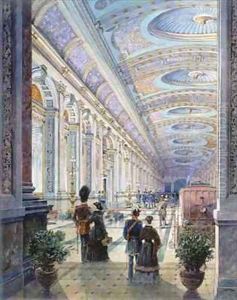Charles H. Driver Paintings
Charles Henry Driver was a distinguished British architect, born in 1832 and passing away in 1900. He was renowned for his innovative work during the Victorian era, particularly in the use of structural iron and steel and the integration of ornamental features into his architectural designs. Driver's career was marked by a keen interest in the industrial and technological advancements of his time, which significantly influenced his architectural style.
After completing his education, Driver began his career working for the London and North Western Railway, where he developed a strong foundation in engineering and architectural design. His work with the railway allowed him to experiment with new materials and construction methods, particularly in the use of iron. Driver's early experiences were pivotal in shaping his later architectural projects, which often featured intricate ironwork and were considered ahead of their time in terms of both aesthetics and structural engineering.
Driver's most notable contributions to architecture include his work on railway stations, public buildings, and bridges. One of his most famous projects was the St Pancras Station in London, where he collaborated with engineer William Henry Barlow. Driver was responsible for the design of the station's elaborate iron and glass roof, which was the largest single-span structure of its time and remains an iconic example of Victorian engineering and architectural design.
Throughout his career, Driver was an active member of various professional organizations, contributing to the discourse on architecture and engineering. He was also involved in several international exhibitions, where he showcased his designs and promoted the integration of art and architecture.
Charles H. Driver's legacy is that of a pioneer in the use of iron and steel in architecture, blending functionality with aesthetic appeal. His work not only reflects the technological innovations of the Victorian era but also continues to inspire architects and engineers today. Despite the fact that some of his buildings have been lost to time, those that remain stand as testaments to his visionary approach to design and his significant impact on the field of architecture.
